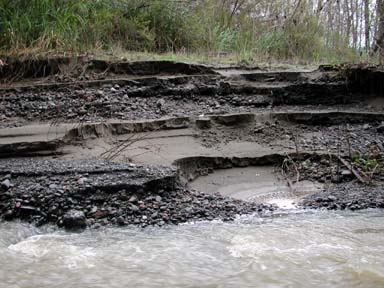






By : Marinel Louise d. Lapada
In addition to releasing gases and particles into the atmosphere, humans produce waste that is dumped on the environment. Often, this waste is hazardous and dangerous to both nature and human life.
As a result, many people and industries are failing to prevent the creation of hazardous waste or to limit the negative effects it produces.
Individuals often throw out goods without realizing that they are headed for a landfill and could be dangerous for the environment. No matter where people put these hazardous waste materials, there is always a chance that they could find their way into the ground, and eventually into our bodies.
Corporations usually want to avoid the costs associated with having to limit creation of hazardous waste. Consequently, they build landfills on site and fill them with waste, or sometimes pay to have their waste removed. Often, hazardous materials are transported to areas that accept money to take the waste.
It may prove very difficult to reduce hazardous waste in the future. Unlike many other environmental problems, waste creation is something people do not often think about.
In the future, people may have to reduce not only their generation of hazardous waste, but also their consumption of many products that end up in landfills.
Causes..
Hazardous waste is produced both on a huge scale by major industries and on a relatively tiny scale by individuals.
One of the main causes of the abundance of hazardous waste is that people do not realize how large a problem it is. Because it can be simply removed and sent to a landfill, it is often assumed that the problem ends there.
Many industries and governments create crude landfills to store waste, and often just dump waste chemicals into nearby bodies of water.
Over 80,000 different chemicals are used in industries worldwide. Often, it is difficult and expensive to get rid of these chemicals and to store them in a way that does not endanger human life or the environment. Obviously, not all of these chemicals are dangerous, but many are and they do create serious problems.
Around the world, hundreds of millions of tons of hazardous waste are produced annually. Rather than cleaning up or storing waste more carefully, one method of reducing the hazardous waste problem may be to simply stop producing so much of it.
Effects
Every year, major health problems result from hazardous waste. Increasing amounts of hazardous waste have caused increasing health problems.
There are over 80,000 chemicals in existence, and many are used commonly in industrial processes. Often, these chemicals find themselves in places where they are able to harm human health.
Insufficient research has been done to provide data on the effects of every chemical. Because waste chemicals often mix together, it will also be necessary to learn how combinations of these chemicals affect human health.
To compound the problem created by a lack of knowledge, 1,500 new chemicals are invented every year and many are introduced into industrial processes.
In 1989, a school in New Jersey had to be closed because students there had suffered excessive exposure to chromium. It was later learned that large amounts of chromium had been dumped nearby, and had blown over to the school area.
Sadly, it is often only after someone has died or become seriously ill that governments will intervene and reduce levels of dumped hazardous waste.
Solutions..



Hazardous waste has created many problems and dangers that have not gone unnoticed. Despite the fact that the problem receives less attention than many other environmental threats, some successful solutions to the problem of hazardous have been suggested and used.
As with air pollution and many other environmental problems, hazardous waste can be controlled through input and output controls.
The government can increase regulations on the disposal of hazardous waste to ensure that problems do not occur. It could also limit the amount of waste industries are allowed to produce, or provide incentives to create less waste.
After hazardous waste has been created, there are several actions that can be taken. Industries can break down chemical compounds into less dangerous forms, or store waste in ways that protect the environment from being exposed to the waste.
Not only major industries but individuals as well must form part of the solution. They can choose not to buy those products which require the production of hazardous waste, attempt to influence policymakers, and produce less hazardous waste themselves.
Many scientists think that waste production can be cut. Experts say that waste can be reduced by at least one-third using existing technologies and methods.


 RED TIDE...WHEN I FIRST HEARD THESE TWO WORDS, WHAT CAME INTO MY MIND WAS THAT THE OCEAN LITERALLY TURNS TO RED AND IT IS BECAUSE OF THE BLOOD OF THE DEAD MARINE ORGANISMS BECAUSE ISN'T IT, WHEN AN OCCURENCE OF RED TIDE IS REPORTED, WE ARE PROHIBITED TO EAT IT BECAUSE OF THE TOXINS THEY MIGHT CONTAIN, BUT THEN, I STILL DO NOT KNOW WHAT CAUSES THE DEATH OF THOSE ORGANISMS, IT IS STILL A BIG QUESTION MARK (?) TO ME. MY THOUGHT ABOUT THIS MATTER WAS STILL SHALLOW AND VERY LITERAL THEN NOT UNTIL I ENTERED SECOND YEAR AND STUDIED BIOLOGY. THIS TOPIC WAS DISCUSSED AND WAS ELABORATED THAT IS WHY I ALREADY HAD ENOUGH OF THE THOUGHT THAT RED TIDE IS CAUSED BY BLOOD.HONESTLY SPEAKING, MY MIND WAS ENLIGHTENED JUST NOW, WHEN I AM A SECOND YEAR STUDENT, (IMAGINE THAT, OF MY 13 YRS. OF EXISTENCE, I BELIEVED THAT BLOOD IS THE MAIN CAUSE OF THIS PHENOMENON!)AND WAS INTRODUCED TO ALGAES.
RED TIDE...WHEN I FIRST HEARD THESE TWO WORDS, WHAT CAME INTO MY MIND WAS THAT THE OCEAN LITERALLY TURNS TO RED AND IT IS BECAUSE OF THE BLOOD OF THE DEAD MARINE ORGANISMS BECAUSE ISN'T IT, WHEN AN OCCURENCE OF RED TIDE IS REPORTED, WE ARE PROHIBITED TO EAT IT BECAUSE OF THE TOXINS THEY MIGHT CONTAIN, BUT THEN, I STILL DO NOT KNOW WHAT CAUSES THE DEATH OF THOSE ORGANISMS, IT IS STILL A BIG QUESTION MARK (?) TO ME. MY THOUGHT ABOUT THIS MATTER WAS STILL SHALLOW AND VERY LITERAL THEN NOT UNTIL I ENTERED SECOND YEAR AND STUDIED BIOLOGY. THIS TOPIC WAS DISCUSSED AND WAS ELABORATED THAT IS WHY I ALREADY HAD ENOUGH OF THE THOUGHT THAT RED TIDE IS CAUSED BY BLOOD.HONESTLY SPEAKING, MY MIND WAS ENLIGHTENED JUST NOW, WHEN I AM A SECOND YEAR STUDENT, (IMAGINE THAT, OF MY 13 YRS. OF EXISTENCE, I BELIEVED THAT BLOOD IS THE MAIN CAUSE OF THIS PHENOMENON!)AND WAS INTRODUCED TO ALGAES. ACCUMULATE IN THE WATER COLUMN OR BLOOM.THESE ALGAE, MORE SPECIFICALLY PHYTOPLANKTON RELEASES PIGMENT ( A CAROTENOID) INTO THE WATER WHICH CAUSES THE DISCOLOURATION OF THE WATER SURFACE AND THIS IS ALSO THE SOURCE OF THE TERM RED TIDE.AS THE STRUCTURE OF THE ALGAE BREAKS DOWN AND RELEASES THE PIGMENT, IT IS USUALLY RELEASED ON THE DEATH OF THE BLOOM.PHYTOPLANKTON, AS WE ALL KNOW ARE SINGLE-CELLED, MICROSCOPIC ,PLAN-LIKE ORGANISMS PROTISTS .
ACCUMULATE IN THE WATER COLUMN OR BLOOM.THESE ALGAE, MORE SPECIFICALLY PHYTOPLANKTON RELEASES PIGMENT ( A CAROTENOID) INTO THE WATER WHICH CAUSES THE DISCOLOURATION OF THE WATER SURFACE AND THIS IS ALSO THE SOURCE OF THE TERM RED TIDE.AS THE STRUCTURE OF THE ALGAE BREAKS DOWN AND RELEASES THE PIGMENT, IT IS USUALLY RELEASED ON THE DEATH OF THE BLOOM.PHYTOPLANKTON, AS WE ALL KNOW ARE SINGLE-CELLED, MICROSCOPIC ,PLAN-LIKE ORGANISMS PROTISTS . IT IS NOT YET CLEAR ON WHAT REALLY CAUSES RED TIDE. IT IS STILL QUESTIONABLE IF IT JUST OCCUR NATURALLY BECAUSE IN OTHER CASES, THEY APPEAR TO BE A RESULT OF HUMAN ACTIVITIES. THERE ARE REPORTS THAT IRON FERTILIZATION MAY CAUSE THIS PHENOMENON WHEREIN THE METHOD OF GEOENGINEERING IS USED BUT THEN AS WHAT IS BELIEVED NOW, RED TIDE IS PURELY A NATURAL PHENOMENON.WHEN TEMPERATURE, SALINITY, AND NUTRIENTS REACH A CERTAIN LEVEL, A MASSIVE INCREASE IN KARENIA brevis ALGAE OCCURS.NO ONE KNOWS THE EXACT COMBINATION OF THESE FACTORS THAT CAUSES RED TIDE, BUT SOME DO BELIEVE THAT HIGH TEMPERATURE COMBINED WITH A OF RAINFALL AND WIND ARE USUALLY THE ROOT OF RED TIDE. STILL, SCIENTISTS AROUND THE WORLD STUDIES RED TIDE AT PRESENT.
IT IS NOT YET CLEAR ON WHAT REALLY CAUSES RED TIDE. IT IS STILL QUESTIONABLE IF IT JUST OCCUR NATURALLY BECAUSE IN OTHER CASES, THEY APPEAR TO BE A RESULT OF HUMAN ACTIVITIES. THERE ARE REPORTS THAT IRON FERTILIZATION MAY CAUSE THIS PHENOMENON WHEREIN THE METHOD OF GEOENGINEERING IS USED BUT THEN AS WHAT IS BELIEVED NOW, RED TIDE IS PURELY A NATURAL PHENOMENON.WHEN TEMPERATURE, SALINITY, AND NUTRIENTS REACH A CERTAIN LEVEL, A MASSIVE INCREASE IN KARENIA brevis ALGAE OCCURS.NO ONE KNOWS THE EXACT COMBINATION OF THESE FACTORS THAT CAUSES RED TIDE, BUT SOME DO BELIEVE THAT HIGH TEMPERATURE COMBINED WITH A OF RAINFALL AND WIND ARE USUALLY THE ROOT OF RED TIDE. STILL, SCIENTISTS AROUND THE WORLD STUDIES RED TIDE AT PRESENT.WELL, I'M DONE WITH MY BLOG NOW, I HOPE YOU ENJOYED READING IT AND YOU WERE ABLE TO GET SOME KNOWLEDGE FROM IT. AND REMEMBER, IT IS NOT CAUSED BY BLOOD OF DEAD MARINE ANIMALS...OKAY?!?!...

,,BYE,,
pauLa zaLdivar
 Water Pollution is the contamination of any body of water. May it be a lake, a stream, a river, etc. Water is necessary to living organisms. Without water, life on Earth would not have started. A body of water can be contaminated by toxins or harmful microorganisms. If one will ingest contaminated water, he or she may develop an illness. Fishes or shells swimming living in contaminated water is unsafe to eat and is hazardous to an organism's health.
Water Pollution is the contamination of any body of water. May it be a lake, a stream, a river, etc. Water is necessary to living organisms. Without water, life on Earth would not have started. A body of water can be contaminated by toxins or harmful microorganisms. If one will ingest contaminated water, he or she may develop an illness. Fishes or shells swimming living in contaminated water is unsafe to eat and is hazardous to an organism's health.  Exxon Valdez Oil Spill Clean-up
Exxon Valdez Oil Spill Clean-up
Chemicals used to kill unwanted animals and plants, for instance on farms or in suburban yards, may be collected by rainwater runoff and carried into streams, especially if these substances are applied too lavishly. Some of these chemicals are biodegradable and quickly decay into harmless or less harmful forms, while others are nonbiodegradable and remain dangerous for a long time.
When animals consume plants that have been treated with certain nonbiodegradable chemicals, such as chlordane and dichlorodiphenyltrichloroethane (DDT), these chemicals are absorbed into the tissues or organs of the animals. When other animals feed on these contaminated animals, the chemicals are passed up the food chain. With each step up the food chain, the concentration of the pollutant increases. In one study, DDT levels in ospreys (a family of fish-eating birds) were found to be 10 to 50 times higher than in the fish that they ate, 600 times the level in the plankton that the fish ate, and 10 million times higher than in the water. Animals at the top of food chains may, as a result of these chemical concentrations, suffer cancers, reproductive problems, and death.
Many drinking water supplies are contaminated with pesticides from widespread agricultural use. More than 14 million Americans drink water contaminated with pesticides, and the Environmental Protection Agency (EPA) estimates that 10 percent of wells contain pesticides. Nitrates, a pollutant often derived from fertilizer runoff, can cause methemoglobinemia in infants, a potentially lethal form of anemia that is also called blue baby syndrome.
3. Heavy Metals
 Copper
Copper
Heavy metals, such as copper, lead, mercury, and selenium, get into water from many sources, including industries, automobile exhaust, mines, and even natural soil. Like pesticides, heavy metals become more concentrated as animals feed on plants and are consumed in turn by other animals. When they reach high levels in the body, heavy metals can be immediately poisonous, or can result in long-term health problems similar to those caused by pesticides and herbicides. For example, cadmium in fertilizer derived from sewage sludge can be absorbed by crops. If these crops are eaten by humans in sufficient amounts, the metal can cause diarrhea and, over time, liver and kidney damage. Lead can get into water from lead pipes and solder in older water systems; children exposed to lead in water can suffer mental retardation.
4. Hazardous Wastes

Hazardous wastes are chemical wastes that are either toxic (poisonous), reactive (capable of producing explosive or toxic gases), corrosive (capable of corroding steel), or ignitable (flammable). If improperly treated or stored, hazardous wastes can pollute water supplies. In 1969 the Cuyahoga River in Cleveland, Ohio, was so polluted with hazardous wastes that it caught fire and burned. PCBs, a class of chemicals once widely used in electrical equipment such as transformers, can get into the environment through oil spills and can reach toxic levels as organisms eat one another.
5. Excess Organic Matter

Fertilizers and other nutrients used to promote plant growth on farms and in gardens may find their way into water. At first, these nutrients encourage the growth of plants and algae in water. However, when the plant matter and algae die and settle underwater, microorganisms decompose them. In the process of decomposition, these microorganisms consume oxygen that is dissolved in the water. Oxygen levels in the water may drop to such dangerously low levels that oxygen-dependent animals in the water, such as fish, die. This process of depleting oxygen to deadly levels is called eutrophication.
6. Sediment

Sediment, soil particles carried to a streambed, lake, or ocean, can also be a pollutant if it is present in large enough amounts. Soil erosion produced by the removal of soil-trapping trees near waterways, or carried by rainwater and floodwater from croplands, strip mines, and roads, can damage a stream or lake by introducing too much nutrient matter. This leads to eutrophication. Eutrophication is a process in which water bodies receive excess nutrients that stimulate excessive plant growth. This enhanced plant growth, often called an algal bloom, reduces dissolved oxygen in the water when dead plant material decomposes and can cause other organisms to die. Sedimentation can also cover streambed gravel in which many fish, such as salmon and trout, lay their eggs.
7. Infectious Organisms

Giardia lambia

Water is often drawn from rivers, lakes, or the ocean for use as a coolant in factories and power plants. The water is usually returned to the source warmer than when it was taken. Even small temperature changes in a body of water can drive away the fish and other species that were originally present, and attract other species in place of them. Thermal pollution can accelerate biological processes in plants and animals or deplete oxygen levels in water. The result may be fish and other wildlife deaths near the discharge source. Thermal pollution can also be caused by the removal of trees and vegetation that shade and cool streams.

Studies of the Exxon Valdez Oil Spills have shown that the environmental damage caused by oil spills can be greater than was previously thought. Petroleum-based hydrocarbons can negatively impact marine life at concentrations as low as one part per billion.
Seabirds are severely affected by spills. The oil penetrates and opens up the structure of their plumage, reducing its insulating ability, and so making the birds more vulnerable to temperature fluctuations and much less buoyant in the water. It also impairs birds' flight abilities, making it difficult or impossible to forage and escape from predators. As they attempt to preen, birds typically ingest oil that coats their feathers, causing kidney damage, altered liverdigestive tract irritation. This and the limited foraging ability quickly causes dehydration and metabolic imbalances. Most birds affected by an oil spill die unless there is human intervention. function, and
Marine mammals exposed to oil spills are affected in similar ways as seabirds. Oil coats the fur of sea otters and seals, reducing its insulation abilities and leading to body temperaturehypothermia. Ingestion of the oil causes dehydration and impaired digestion. fluctuations and
A sheen is usually dispersed (but not cleaned up) with detergents which makes oil settle to the bottom. Oils that are denser than water, such as Polychlorinated Biphenyls (PCBs), can be more difficult to clean as they make the seabed toxic.
Clean-up efforts after Exxon Valdez oil spill.
Experiencing Oil Spills makes an economic crisis,for the reason, that we will be having a hard time removing all the oil. And by this, instead of earning more money for our country, we are obligated to pay a high maintenance machine to suck it all, and worse, the people who are living near it will be having a hard time looking for a new diverse job to earn money for there family.
Here are the methods that we have to do to clean up the oil spills
Methods for cleaning up include:
Equipment used includes:
 Introduction
Introduction Cause
Cause  Effect
Effect
